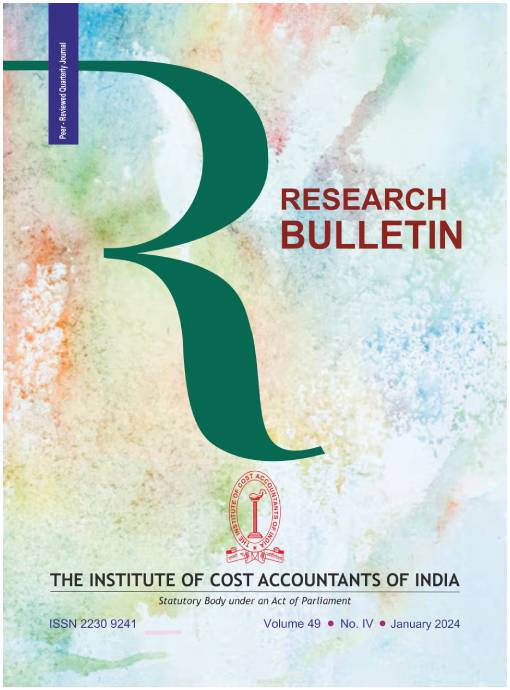India's Tea Trade in the Post Globalisation Arena: An Analysis
DOI:
https://doi.org/10.33516/maj.v59i7.84-89pKeywords:
No Keywords.Abstract
The New Economic Policy was introduced by the Government of India in 1991 by incorporating the concepts of liberalisation, market orientation, privatisation and globalisation for the first time. India's tea business has suffered from the effects of globalization, increased competition from other beverages, and import risks. In the years following liberalization, the percentage of Indian tea exports has significantly decreased. In this context, it is pertinent to throw some insights into a few concepts relating to tea industry due to liberalisation and the present study provides an insight into production and export scenario of Indian tea industry in post globalisation period.
Downloads
Downloads
Published
How to Cite
Issue
Section
References
Arya, N., (2013), “Indian Tea Scenario”, International Journal of Scientific and Research Publications, 3(7), (July).
Asopa, V.N., (2004), “Competitiveness in Global Tea Trade”, Oxford and IBH Publishing Company Pvt. Ltd., New Delhi, India.
Banerjee, B., (2005), “E-Auction of Tea in India”, Tea Board of India, Kolkata, (15th December).
Banerjee, B., (2010), “Fundamentals of Financial Management”, PHI Learning Pvt. Ltd., New Delhi.
Banerjee, G. & Banerjee, S., (2008), “Tea Industry: A Road Map Ahead”,Abhijeet Publications, New Delhi.
Banerjee, G. & Banerjee, S., (2009), “Tea Industry in Transition”,Abhijeet Publications, New Delhi.
Banerjee, G.D. & Banerjee, S., (2008), “Export Potential of Indian Tea”,Abhijeet Publications, New Delhi
Banerjee, G.D. & Banerjee, S., (2008), “Global Tea Trade: Dimensions and Dynamics”, Abhijeet Publications, New Delhi, India.
Banerjee, G.D., (2000), “Marketing of Tea is no longer a fashionable Slogan”, India Association of Social Science Institutions Journal.
Baruah, Pradip (2008) “The Tea Industry of Assam: Origin and Development”, EBH Publishers, Guwahati, Assam, pp. 23-59 and 61-102.
Das, G.R. (2008) “Impact of Globalisation on Tea and Silk Industry of Assam” in Deb B, Sengupta, K and Datta Roy, B (ed.) Globalisation and North East India, Concept Publishing Company , New Delhi.
Das, P.P., (2006), “BorakeChashilperMrityuyatrarItikotha (Bengali)”, SamoikProsongo, (5th November), No. 200.
Dasgupta, B (2008) “Impact of New Economic Policy on Tea Industry of Assam” in Deb B, Sengupta, K and Datta Roy, B (ed.) Globalisation and North East India, Concept Publishing Company, New Delhi.
Dutt, Himangshu, 2007 “The Turnaround of Indian Tea Sector”, Delhi Business Review, 8(1).
Ganewatta, et. al., (2006), “Impact of Protection on Domestic Processing of Primary Commodities for Export Markets”, South Asia Economic Journal, 7(1), Sage Publication, New Delhi.
Hettiarachchi, L., (2007), “Tea Industry-Everyone Has Problems”, The Sunday Times Online, 42(12), (August 19), Sri Lanka.
Kar Deb, Ajanta & Mathew, Binu, (2012), “Tea Industry in West Garo Hills District of Meghalaya- A Micro analysis”, Source-A Peer Reviewed Journal of Humanities and Social Sciences,Vol.II, August, 93-104.
Khaliqi, M., Gurning, H.R.H., Novanda, R. R. And Simamora, O. N.(2020): “Competitiveness Indonesia tea in international market”, IOP Conf. Series: Earth and Environmental Science 454 (2020) 012039, (Source: https://iopscience.iop. Org/article/10.1088/1755-1315/454/1/012039/pdf Visited: 23/12/2023)
Kumar, Purnendu, (2006), “State and Society in North East India- A Study of Immigrant Tea Plantation Labourers”, Regency Publications, New Delhi, 86-93.
Muflihah, Ulfah, Mutolib, Abdul and Nuraini, Candra (2023): “Analysis of Indonesian Tea Export Competitiveness on the International Market”, East Asian Journal of Multidisciplinary Research, Vol. 2, No. 10.
Nagoor, B. H. (2021): Market Integration And Changing Direction of Trade: Case Of India’s Trade In Tea, (Source: http://localhost:8080/xmlui/handle/ 123456789/ 538, visited: 23/12/2023)
Rao, C. N., (2005), “Geographical Indications in Indian Context: A Case Study of Darjeeling Tea”, Economic and Political Weekly, October, XL (42), 15-21.
Sengupta, S., (2009), “Tea to get Smart Makeover to Capture Young Market”, Times of India, Dated: 9th November.
Sha, S. K. And Pate, V.A. (2016): “Tea production in India: Challenges and Opportunities”, Journal of Tea Science Research, Vol. 6, No.5.
Sivanesan, R (2013): “Tea Industry in India–Analysis of Import and Export of Tea”, International Journal of Business and Management Invention, Volume 2 Issue 8, August.
Talukdar, U and Udeshna, C (2017): “Production and export of value added tea in India and It’s Global competitiveness”, Economic Affairs, , Volume: 62 pp. 705-710.
Thapa, A., (2005), “Concept Paper on Study of Nepalese Tea Industry Vision-2020”, Nepal Tree Crop Global Development Alliance (NTCGDA),Winrock International, Baneshwor, Kathmandu.




 Free Sample
Free Sample Editorial Policy
Editorial Policy

